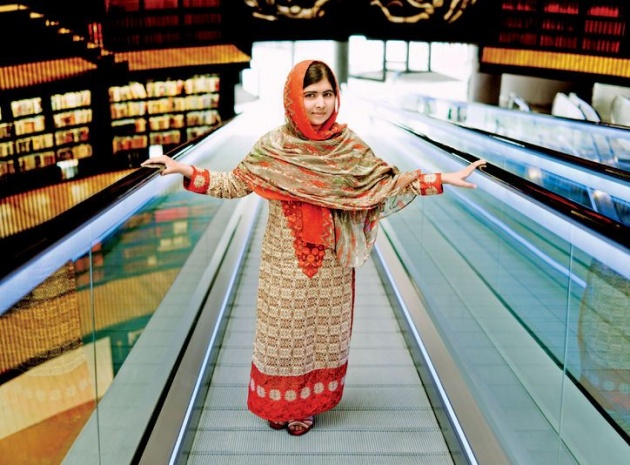
Malala Yousafzai S.St (Malālah Yūsafzay: Urdu: ملالہ یوسفزئی; Pashto: ملاله یوسفزۍ[məˈlaːlə jusəf ˈzəj];[1] born 12 July 1997)[2][3] is a Pakistani activist for female education and the youngest-ever Nobel Prize laureate.[4] She is known mainly for human rights advocacy for education and for women in her native Swat Valley in the Khyber Pakhtunkhwa province of northwest Pakistan, where the local Taliban had at times banned girls from attending school. Yousafzai's advocacy has since grown into an international movement.
Her family runs a chain of schools in the region. In early 2009, when she was 11–12, Yousafzai wrote a blog under a pseudonym for the BBC detailing her life under Taliban occupation, their attempts to take control of the valley, and her views on promoting education for girls in the Swat Valley. The following summer, journalist Adam B. Ellick made a New York Times documentary[3]about her life as the Pakistani military intervened in the region. Yousafzai rose in prominence, giving interviews in print and on television, and she was nominated for the International Children's Peace Prize by South African activistDesmond Tutu.
On the afternoon of October 9, 2012, Yousafzai boarded her school bus in the northwest Pakistani district of Swat. A gunman asked for her by name, then pointed a pistol at her and fired three shots. One bullet hit the left side of Yousafzai's forehead, travelled under her skin through the length of her face, and then went into her shoulder.[5] In the days immediately following the attack, she remained unconscious and in critical condition, but later her condition improved enough for her to be sent to the Queen Elizabeth Hospital in Birmingham, England, for intensive rehabilitation. On 12 October, a group of 50 Muslim clerics in Pakistan issued a fatwā against those who tried to kill her, but the Taliban reiterated their intent to kill Yousafzai and her father, Ziauddin Yousafzai. The assassination attempt sparked a national and international outpouring of support for Yousafzai. Deutsche Welle wrote in January 2013 that Yousafzai may have become "the most famous teenager in the world."[6]United Nations Special Envoy for Global Education Gordon Brown launched a UN petition in Yousafzai's name, demanding that all children worldwide be in school by the end of 2015; it helped lead to the ratification of Pakistan's first Right to Education Bill.[7]
The 2013, 2014 and 2015 issues of Time magazine featured Yousafzai as one of "The 100 Most Influential People in the World". She was the winner of Pakistan's first National Youth Peace Prize, and the recipient of the 2013 Sakharov Prize. In July that year, she spoke at the headquarters of the United Nations to call for worldwide access to education, and in October the Government of Canada announced its intention that its parliament confer Honorary Canadian citizenship upon Yousafzai.[8] In February 2014, she was nominated for the World Children's Prize in Sweden.[9] Even though she was fighting for women's rights as well as children's rights, she did not describe herself as feminist when asked on Forbes Under 30 Summit in 2014.[10][11] In 2015, however, Yousafzai told Emma Watson she decided to call herself a feminist after hearing Watson's speech at the UN launching the HeForShe campaign.[12] In May 2014, Yousafzai was granted an honorary doctorate by the University of King's College in Halifax, Nova Scotia.[13] Later in 2014, Yousafzai was announced as the co-recipient of the 2014 Nobel Peace Prize, along with Kailash Satyarthi, for her struggle against the suppression of children and young people and for the right of all children to education. Aged 17 at the time, Yousafzai became the youngest-ever Nobel Prize laureate.[14][15][16] She was the subject of Oscar-shortlisted 2015 documentary He Named Me Malala.[17]
Since March 2013, she has been a pupil at the all-girls' Edgbaston High School in Birmingham, England.[18] On 20 August 2015, she achieved a string of A's and A*s in her GCSE exams
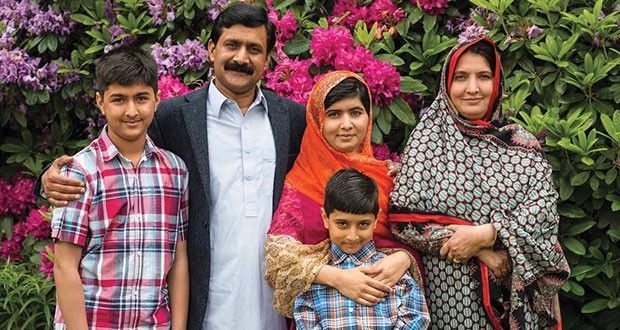
Early life[edit]
Childhood[edit]
Malala Yousafzai was born on 12 July 1997 in the Swat District of Pakistan's northwestern Khyber Pakhtunkhwa province, into a Sunni Muslim family[3] of Pashtun ethnicity.[20] She was given her first name Malala (meaning "grief-stricken")[21] afterMalalai of Maiwand, a famous Pushtu poetess and warrior woman from southern Afghanistan.[22] Her last name, Yousafzai, is that of a large Pashtun tribal confederation that is predominant in Pakistan's Swat Valley, where she grew up. At her house in Mingora, she lived with her two younger brothers, her parents, Ziauddin and Tor Pekai, and two pet chickens.[3]
Fluent in Pashto, English, and Urdu, Yousafzai was educated in large part by her father, Ziauddin Yousafzai, who is a poet, school owner,[23] and an educational activist himself, running a chain of private schools known as the Khushal Public School.[24][25] She once stated to an interviewer that she would like to become a doctor, though later her father encouraged her to become a politician instead.[3] Ziauddin referred to his daughter as something entirely special, permitting her to stay up at night and talk about politics after her two brothers had been sent to bed.[26]
Yousafzai started speaking about education rights as early as September 2008, when her father took her to Peshawar to speak at the local press club. "How dare the Taliban take away my basic right to education?" Yousafzai asked her audience in a speech covered by newspapers and television channels throughout the region.[27]
In 2009, Yousafzai began as a trainee and then a peer educator in the Institute for War and Peace Reporting's Open Minds Pakistan youth programme, which worked in schools in the region to help young people engage in constructive discussion on social issues through the tools of journalism, public debate and dialogue.[28]
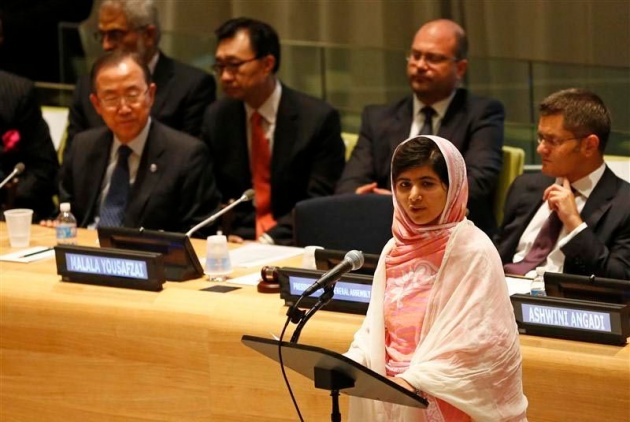
As a BBC blogger[edit]
See also: First Battle of Swat
In late 2008, Aamer Ahmed Khan of the BBC Urdu website and his colleagues came up with a novel way of covering theTaliban's growing influence in Swat. They decided to ask a schoolgirl to blog anonymously about her life there. Their correspondent in Peshawar, Abdul Hai Kakar, had been in touch with a local school teacher, Ziauddin Yousafzai, but couldn't find any students willing to do it. It was considered too dangerous by their families. Finally, Yousafzai suggested his own daughter, 11-year-old Malala.[29] At the time, Taliban militants led by Maulana Fazlullah were taking over the Swat Valley, banning television, music, girls' education,[30] and women from going shopping.[31] Bodies of beheaded policemen were being hung in town squares.[30] At first, a girl named Aisha from her father's school agreed to write a diary, but then the girl's parents stopped her from doing it because they feared Taliban reprisals. The only alternative was Yousafzai, four years younger than the original volunteer, and in seventh grade at the time.[32] Editors at the BBC unanimously agreed.[30]
I had a terrible dream yesterday with military helicopters and the Taliban. I have had such dreams since the launch of the military operation in Swat. My mother made me breakfast and I went off to school. I was afraid going to school because the Taliban had issued an edict banning all girls from attending schools.
Only 11 out of 27 pupils attended the class because the number decreased because of the Taliban's edict. My three friends have shifted to Peshawar, Lahore and Rawalpindi with their families after this edict.
“
”
Malala Yousafzai, 3 January 2009 BBC blog entry[21]
"We had been covering the violence and politics in Swat in detail but we didn't know much about how ordinary people lived under the Taliban," Mirza Waheed, the former editor of BBC Urdu, said. Because they were concerned about Yousafzai's safety, BBC editors insisted that she use a pseudonym.[30] Her blog was published under the byline "Gul Makai" ("cornflower" in Urdu),[33] a name taken from a character in a Pashtun folktale.[34][35]
On 3 January 2009, Yousafzai's first entry was posted to the BBC Urdu blog. She would hand-write notes and then pass them on to a reporter who would scan and e-mail them.[30] The blog records Yousafzai's thoughts during the First Battle of Swat, as military operations take place, fewer girls show up to school, and finally, her school shuts down.
In Mingora, the Taliban had set an edict that no girls could attend school after 15 January 2009. The group had already blown up more than a hundred girls' schools.[30] The night before the ban took effect was filled with the noise of artillery fire, waking Yousafzai several times. The following day, Yousafzai also read for the first time excerpts from her blog that had been published in a local newspaper.[21]
Banned from school[edit]
After the ban, the Taliban continued to destroy schools in the area.[36] Five days later in her blog, Yousafzai wrote that she was still studying for her exams: "Our annual exams are due after the vacations but this will only be possible if the Taliban allow girls to go to school. We were told to prepare certain chapters for the exam but I do not feel like studying."[36]
It seems that it is only when dozens of schools have been destroyed and hundreds others closed down that the army thinks about protecting them. Had they conducted their operations here properly, this situation would not have arisen.
“
”
Malala Yousafzai, 24 January 2009 BBC blog entry[36]
In February 2009, girls' schools were still closed. In solidarity, private schools for boys had decided not to open until 9 February, and notices appeared saying so.[36] On 7 February, Yousafzai and a brother returned to their hometown of Mingora, where the streets were deserted, and there was an "eerie silence". "We went to the supermarket to buy a gift for our mother but it was closed, whereas earlier it used to remain open till late. Many other shops were also closed", she wrote in her blog. Their home had been robbed and their television was stolen.[36]
After boys' schools reopened, the Taliban lifted restrictions on girls' primary education, where there was co-education. Girls-only schools were still closed. Yousafzai wrote that only 70 pupils attended, out of 700 pupils who were enrolled.[36]
On 15 February, gunshots could be heard in the streets of Mingora, but Yousafzai's father reassured her, saying "don't be scared – this is firing for peace". Her father had read in the newspaper that the government and the militants were going to sign a peace deal the next day. Later that night, when the Taliban announced the peace deal on their FM Radio studio, another round of stronger firing started outside.[36] Yousafzai spoke out against the Taliban on the national current affairs show Capital Talk on 18 February.[37] Three days later, local Taliban leader Maulana Fazlulla announced on his FM radio station that he was lifting the ban on women's education, and girls would be allowed to attend school until exams were held on 17 March, but they had to wear burqas.[36]
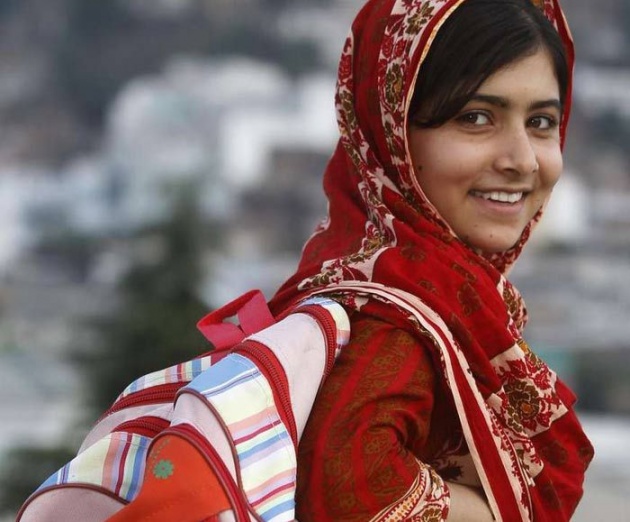
Girls' schools reopen[edit]
On 25 February, Yousafzai wrote on her blog that she and her classmates "played a lot in class and enjoyed ourselves like we used to before".[36] Attendance at Yousafzai's class was up to 19 of 27 pupils by 1 March, but the Taliban were still active in the area. Shelling continued, and relief goods meant for displaced people were looted.[36] Only two days later, Yousafzai wrote that there was a skirmish between the military and Taliban, and the sounds of mortar shells could be heard: "People are again scared that the peace may not last for long. Some people are saying that the peace agreement is not permanent, it is just a break in fighting".[36]
On 9 March, Yousafzai wrote about a science paper that she performed well on, and added that the Taliban were no longer searching vehicles as they once did. Her blog ended on 12 March 2009.[38]
As a displaced person[edit]
See also: Second Battle of Swat
After the BBC diary ended, Yousafzai and her father were approached by New York Times reporter Adam B. Ellick about filming a documentary.[32] In May, the Pakistani Army moved into the region to regain control during the Second Battle of Swat. Mingora was evacuated and Yousafzai's family was displaced and separated. Her father went to Peshawar to protest and lobby for support, while she was sent into the countryside to live with relatives. "I'm really bored because I have no books to read," Yousafzai is filmed saying in the documentary.[3]
That month, after criticising militants at a press conference, Yousafzai's father received a death threat over the radio by a Taliban commander.[3] Yousafzai was deeply inspired in her activism by her father. That summer, for the first time, she committed to becoming a politician and not a doctor, as she had once aspired to be.[3]
I have a new dream ... I must be a politician to save this country. There are so many crises in our country. I want to remove these crises.
“
”
Malala Yousafzai, Class Dismissed (documentary)[3]
By early July, refugee camps were filled to capacity. The prime minister made a long-awaited announcement saying that it was safe to return to the Swat Valley. The Pakistani military had pushed the Taliban out of the cities and into the countryside. Yousafzai's family reunited, and on 24 July 2009 they headed home. They made one stop first – to meet with a group of other grassroots activists that had been invited to see United StatesPresident Barack Obama's special representative to Afghanistan and Pakistan, Richard Holbrooke. Yousafzai pleaded with Holbrooke to intervene in the situation, saying, "Respected ambassador, if you can help us in our education, so please help us." When her family finally did return home, they found it had not been damaged, and her school had sustained only light damage.[3]
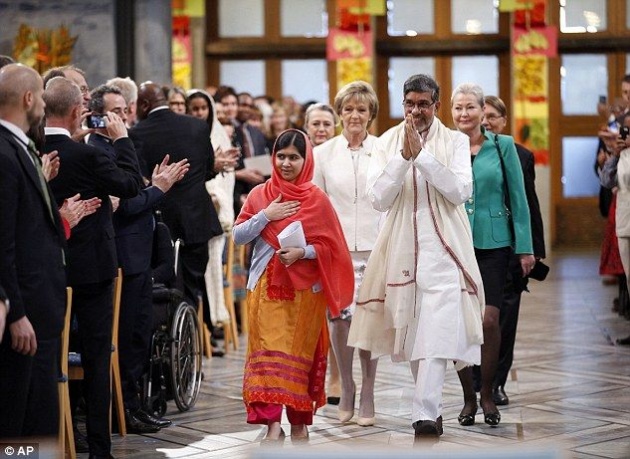
Early activism[edit]
Following the documentary, Yousafzai was interviewed on the national Pashto-language station AVT Khyber, the Urdu-language Daily Aaj, and Canada's Toronto Star.[32] She made a second appearance on Capital Talk on 19 August 2009.[39]Her BBC blogging identity was being revealed in articles by December 2009.[40][41] She also began appearing on television to publicly advocate for female education.[31]
In October 2011, Archbishop Desmond Tutu, a South African activist, nominated Yousafzai for the International Children's Peace Prize of the Dutch international children's advocacy group KidsRights Foundation. She was the first Pakistani girl to be nominated for the award. The announcement said, "Malala dared to stand up for herself and other girls and used national and international media to let the world know girls should also have the right to go to school".[42] The award was won by Michaela Mycroft of South Africa.[43]
Her public profile rose even further when she was awarded Pakistan's first National Youth Peace Prize two months later in December.[30][42] On 19 December 2011, Prime Minister Yousaf Raza Gillani awarded her the National Peace Award for Youth. At the proceedings in her honour, Yousafzai stated that she was not a member of any political party, but hoped to found a national party of her own to promote education.[44] The prime minister directed the authorities to set up an IT campus in the Swat Degree College for Women at Yousafzai's request, and a secondary school was renamed in her honour.[45] By 2012, Yousafzai was planning to organise the Malala Education Foundation, which would help poor girls go to school.[46]
Assassination attempt[edit]
As Yousafzai became more recognised, the dangers facing her increased. Death threats against her were published in newspapers and slipped under her door.[47] On Facebook, where she was an active user, she began to receive threats and fake profiles were created under her name.[30] When none of this worked, a Taliban spokesman says they were "forced" to act. In a meeting held in the summer of 2012, Taliban leaders unanimously agreed to kill her.[47]
I think of it often and imagine the scene clearly. Even if they come to kill me, I will tell them what they are trying to do is wrong, that education is our basic right.
“
”
Malala Yousafzai envisioning a confrontation with the Taliban[30]
On 9 October 2012, a Taliban gunman shot Yousafzai as she rode home on a bus after taking an exam in Pakistan's Swat Valley. The masked gunman shouted "Which one of you is Malala? Speak up, otherwise I will shoot you all",[25] and, on her being identified, shot at her. She was hit with one bullet, which went through her head, neck, and ended in her shoulder.[48] Two other girls were also wounded in the shooting: Kainat Riaz and Shazia Ramzan,[49] both of whom were stable enough to speak to reporters and provide details of the attack.
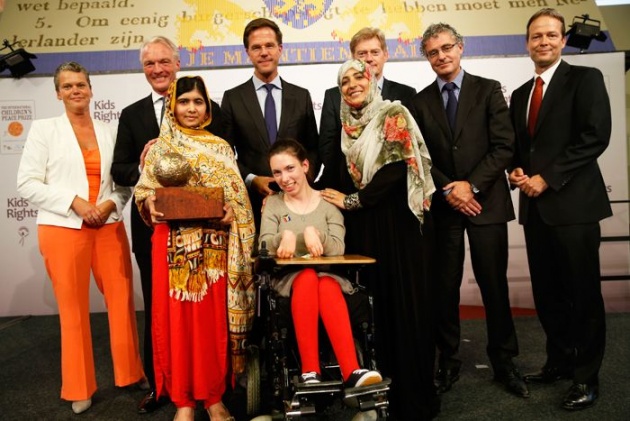
Medical treatment[edit]
After the shooting, Yousafzai was airlifted to a military hospital in Peshawar, where doctors were forced to begin operating after swelling developed in the left portion of her brain, which had been damaged by the bullet when it passed through her head.[50] After a five-hour operation, doctors successfully removed the bullet, which had lodged in her shoulder near her spinal cord. The day following the attack, doctors performed a decompressive craniectomy, in which part of the skull is removed to allow room for the brain to swell.[51]
On 11 October 2012, a panel of Pakistani and British doctors decided to move Yousafzai to the Armed Forces Institute of Cardiology in Rawalpindi.[51] Mumtaz Khan, a doctor, said that she had a 70% chance of survival.[52] Interior MinisterRehman Malik said that Yousafzai would be moved to Germany, where she could receive the best medical treatment, as soon as she was stable enough to travel. A team of doctors would travel with her, and the government would bear the expenditures of her treatment.[53][54] Doctors reduced Yousafzai's sedation on 13 October, and she moved all four limbs.[55]
Offers to treat Yousafzai came from around the world.[56] On 15 October, Yousafzai travelled to the United Kingdom for further treatment, approved by both her doctors and family. Her plane landed in Abu Dhabi for refuelling and then continued to Birmingham, where she was treated at the Queen Elizabeth Hospital Birmingham, one of the specialties of this hospital being the treatment of military personnel injured in conflict.[57] According to the UK Government "The Pakistani government is paying all transport, migration, medical, accommodation and subsistence costs for Malala and her party".[58]
Yousafzai had come out of her coma by 17 October 2012, was responding well to treatment, and was said to have a good chance of fully recovering without any brain damage.[59] Later updates on 20 and 21 October stated that she was stable, but was still battling an infection.[60] By 8 November, she was photographed sitting up in bed.[61]
On 3 January 2013, Yousafzai was discharged from the hospital to continue her rehabilitation at her family's temporary home in the West Midlands.[62][63] She had a five-hour operation on 2 February to reconstruct her skull and to receive acochlear implant to restore her hearing, and was reported in stable condition.[64][65]
Reaction[edit]
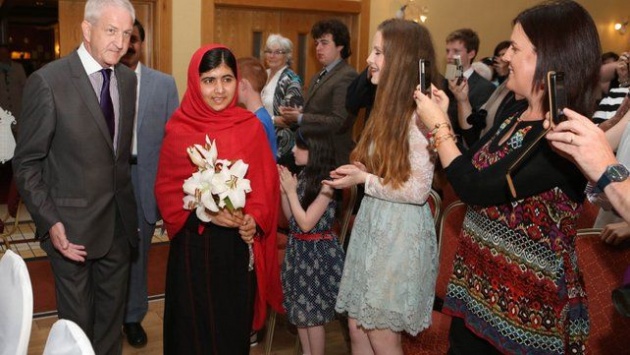
Barack Obama, Michelle Obama, and their daughter Malia meet with Malala Yousafzai in theOval Office, 11 October 2013
The assassination attempt received worldwide media coverage and produced an outpouring of sympathy and anger. Protests against the shooting were held in several Pakistani cities the day after the attack, and over 2 million people signed the Right to Education campaign's petition, which led to ratification[66][67] of the first Right to Education Bill in Pakistan.[7] Pakistani officials offered a 10 million rupee (US$105,000) reward for information leading to the arrest of the attackers. Responding to concerns about his safety, Yousafzai's father said, "We wouldn't leave our country if my daughter survives or not. We have an ideology that advocates peace. The Taliban cannot stop all independent voices through the force of bullets."[54]
Pakistan's president Asif Ali Zardari described the shooting as an attack on "civilized people".[68] UN Secretary-General Ban Ki-moon called it a "heinous and cowardly act".[69] United States President Barack Obama found the attack "reprehensible, disgusting and tragic",[70] while Secretary of State Hillary Clinton said Yousafzai had been "very brave in standing up for the rights of girls" and that the attackers had been "threatened by that kind of empowerment".[71] British Foreign Secretary William Haguecalled the shooting "barbaric" and that it had "shocked Pakistan and the world".[72]
American singer Madonna dedicated her song "Human Nature" to Yousafzai at a concert in Los Angeles the day of the attack,[73] as well had a temporary Malala tattoo on her back.[74] American actress Angelina Jolie wrote an article about explaining the event to her children and answering questions like "Why did those men think they needed to kill Malala?"[75]Jolie later donated $200,000 to The Malala Fund[76] for girls education.[77] Former First Lady of the United States Laura Bush wrote an op-ed piece in The Washington Post in which she compared Yousafzai to Holocaust diarist Anne Frank.[78]Indian director Amjad Khan announced that he would be making a biographical film based on Malala Yousafzai.[79]
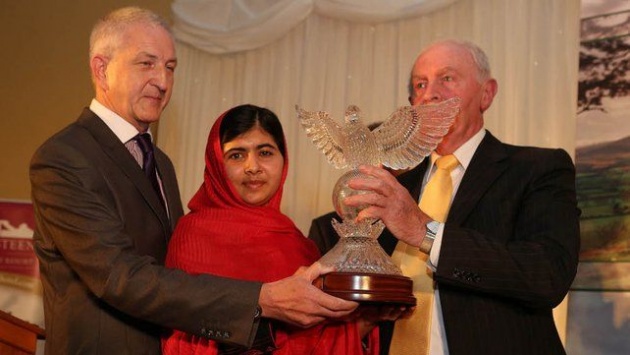
Ehsanullah Ehsan, chief spokesman for the Pakistani Taliban, claimed responsibility for the attack, saying that Yousafzai "is the symbol of the infidels and obscenity," adding that if she survived, the group would target her again.[80] In the days following the attack, the Taliban reiterated its justification, saying Yousafzai had been brainwashed by her father: "We warned him several times to stop his daughter from using dirty language against us, but he didn't listen and forced us to take this extreme step".[49] The Taliban also justified its attack as part of religious scripture, stating that the Quran says that "people propagating against Islam and Islamic forces would be killed", going on to say that "Sharia says that even a child can be killed if he is propagating against Islam".[81]
On 12 October 2012, a group of 50 Islamic clerics in Pakistan issued a fatwā – a ruling of Islamic law – against the Taliban gunmen who tried to kill Yousafzai. Islamic scholars from the Sunni Ittehad Council publicly denounced attempts by the Pakistani Taliban to mount religious justifications for the shooting of Yousafzai and two of her classmates.[82]
Although the attack was roundly condemned in Pakistan,[83] "some fringe Pakistani political parties and extremist outfits" have aired conspiracy theories, such as the shooting being staged by the American Central Intelligence Agency to provide an excuse for continuing drone attacks.[84] The Tehrik-i-Taliban Pakistan and some other pro-Taliban elements branded Yousafzai as an "American spy".[85][86][87][88]
United Nations petition[edit]
On 15 October 2012, UN Special Envoy for Global Education Gordon Brown, a former British Prime Minister, visited Yousafzai while she was in the hospital,[89] and launched a petition in her name and "in support of what Malala fought for".[90]Using the slogan "I am Malala", the petition's main demand was that there be no child left out of school by 2015, with the hope that "girls like Malala everywhere will soon be going to school".[91] Brown said he would hand the petition to President Zardari in Islamabad in November.[90]
The petition contains three demands:
We call on Pakistan to agree to a plan to deliver education for every child.
We call on all countries to outlaw discrimination against girls.
We call on international organisations to ensure the world's 61 million out-of-school children are in education by the end of 2015.[91]
Criminal investigation, arrests, and acquittals[edit]
The day after the shooting, Pakistan's Interior Minister Rehman Malik stated that the Taliban gunman who shot Yousafzai had been identified.[92] Police named 23-year-old Atta Ullah Khan, a graduate student in chemistry, as the gunman in the attack.[93] As of July 2013 he remains at large.[94]
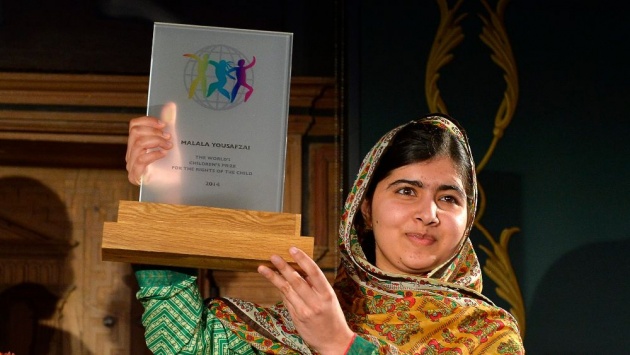
The police also arrested six men for involvement in the attack, but they were later released for lack of evidence.[94] As of 7 November 2012, Mullah Fazlullah, the cleric who ordered the attack on Yousafzai, was confirmed to be hiding in Eastern Afghanistan by US sources there.[95]
On 12 September 2014, ISPR Director, Major General Asim Bajwa, told a media briefing in Islamabad that the 10 attackers belong to a militant group called "Shura". General Bajwa said that Israrur Rehman was the first militant group member who was identified and apprehended by the troops. Acting upon the information received during his interrogation, all other members of the militant group were arrested. It was an intelligence-based joint operation conducted by ISI, police, and military.[96][97]
In April 2015, the ten who were arrested were sentenced to life in prison by Judge Mohammad Amin Kundi, a counterterrorism judge, with the chance of eligibility for parole, and possible release, after 25 years. It is not known if the actual would-be assassins were among the ten sentenced.[98] In June 2015, it was revealed that eight of the ten men tried in-camera for the attack had in fact been secretly acquitted, insiders revealed one of the men acquitted and freed was the murder bid’s mastermind. It is believed that all other men who shot Malala fled to Afghanistan afterwards and were never even captured. The information about the release of suspects came to light after the London Daily Mirror attempted to locate the men in prison. Senior police official Salim Khan stated that the eight men were released because there was not enough evidence to connect them to the attack.[99][100][101]



